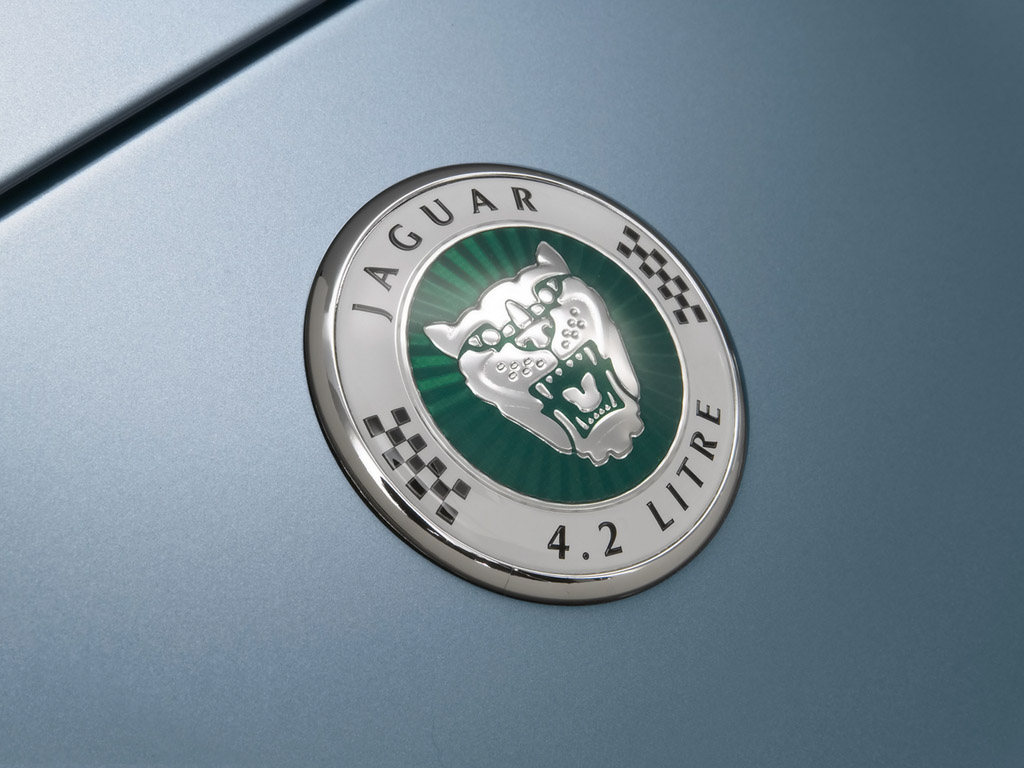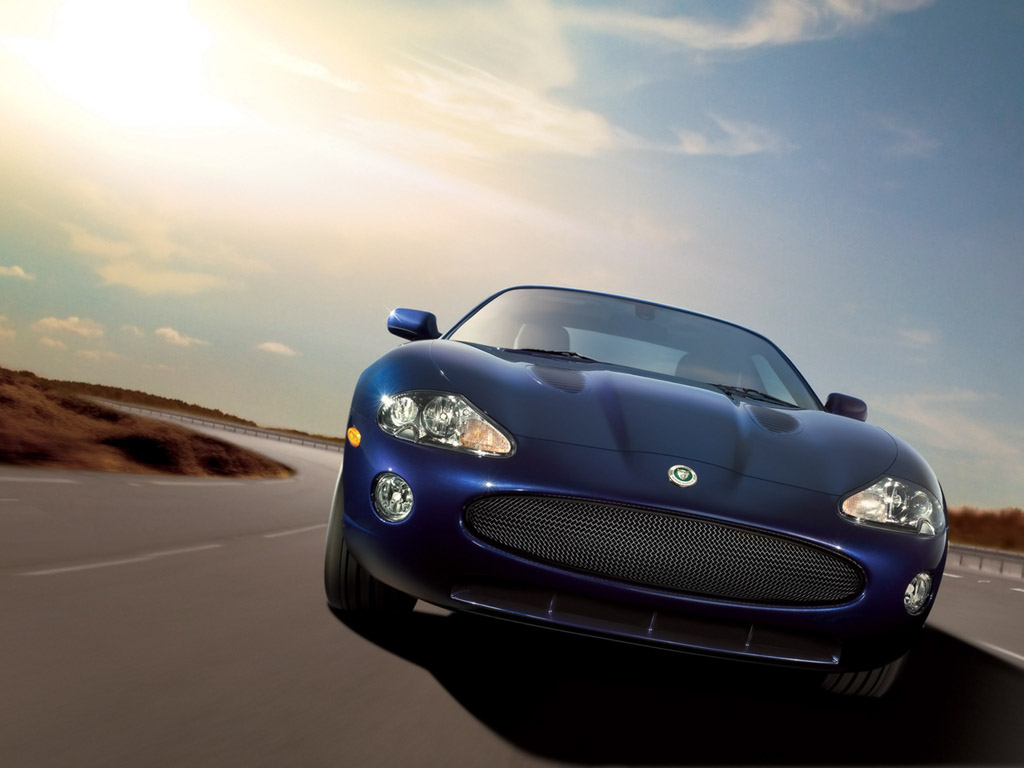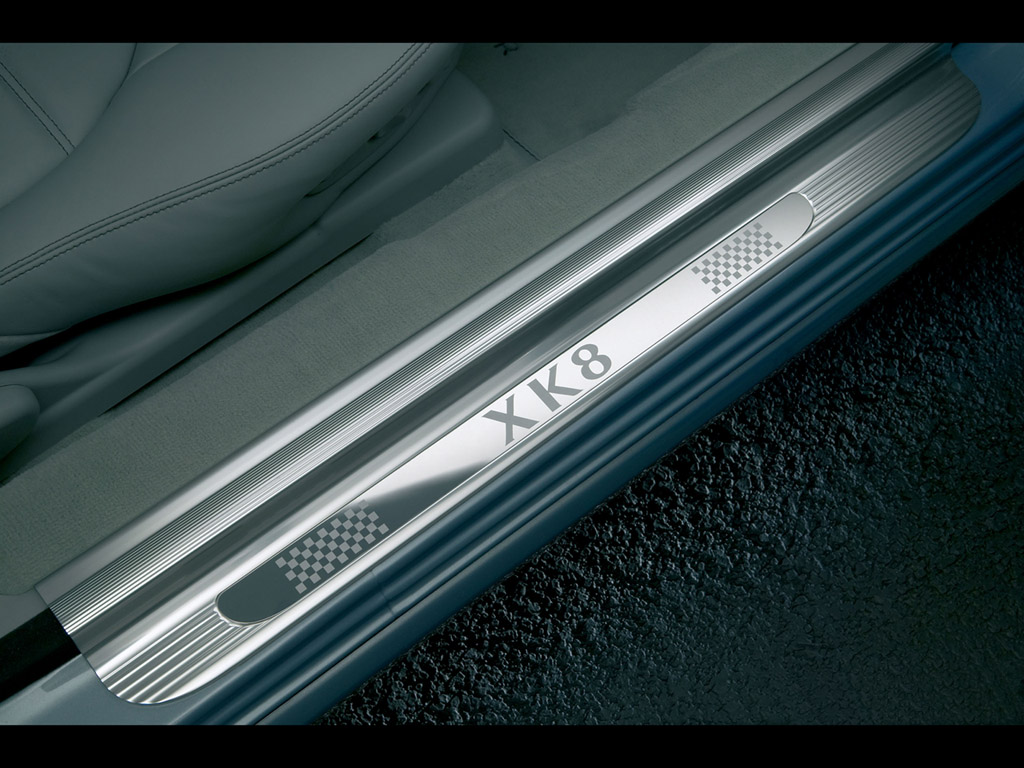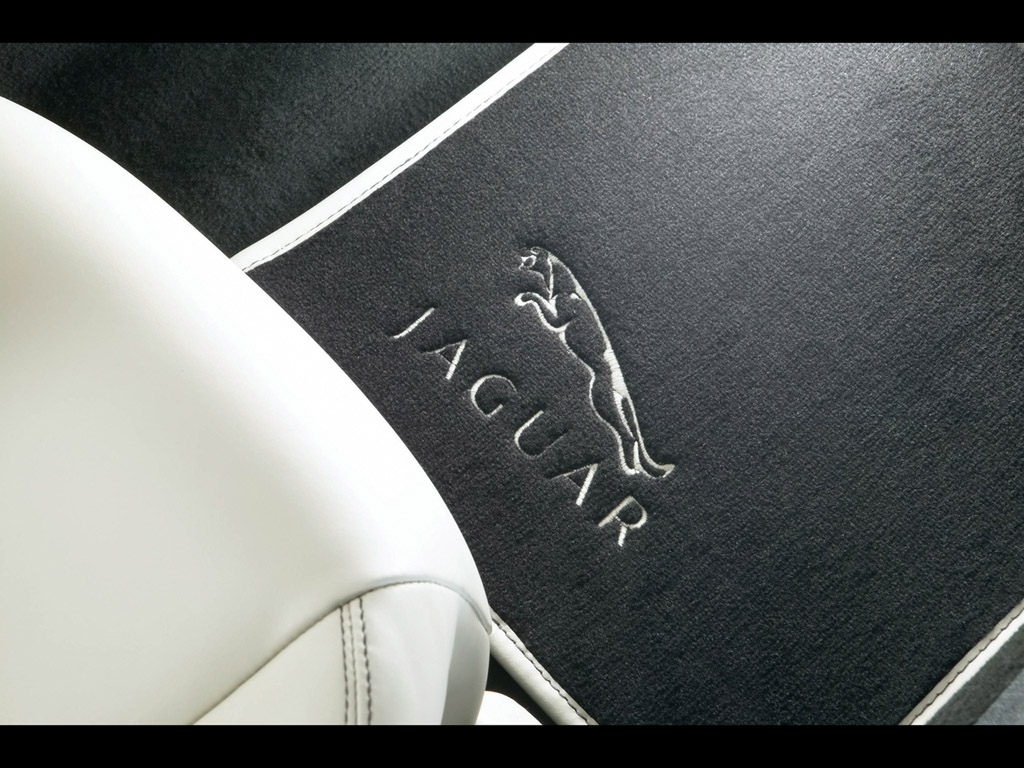2006 Jaguar XK Victory Edition
(from Jaguar Press
Release) "The XK is Jaguar's leading beautiful, fast car.
With sensuous lines, rich appointments and thrilling performance, it
has remained on the shopping list of automotive enthusiasts for more
than six decades."
C.J. O’Donnell, Executive Vice President, Marketing, Sales and
Communications, Jaguar North America
Making their world debut at the 2005 Los Angeles Auto Show, the 2006
model year Jaguar XK 'Victory' editions celebrate Jaguar's four
championship wins in the North American Trans-Am road racing series
and add to a successful lineage of special and limited edition XKs
introduced since its launch.
Now a familiar sight on the racetracks of North America, the racing
version of the XKR coupe has achieved three of four outright
Manufacturer's Championship wins in the Trans-Am Series for Jaguar.
For the 2004 season, Jaguar claimed its fourth title – second in a
row – when the Jaguar R Performance XKR, driven by Paul Gentilozzi,
propelled him to his 29th career Trans-Am victory, tying the
legendary Mark Donohue's career Trans-Am win record.
From the landmark XK120 sports car that first introduced the famous
XK name in 1948, through the current range of XK8 and XKR coupes and
convertibles, the XK nameplate has become synonymous with style,
luxury, performance and grand touring ability. Just 1,050 of the
special 'Victory' edition XKs will be sold in the U.S. beginning in
June 2005.
"The XK ‘Victory’ edition is not only a celebration of the XK’s
success in Trans-Am, but also its enduring success as one of the
world’s most refined GT cars," adds O’Donnell.
All four XK models – XK8 Coupe and Convertible and supercharged XKR
Coupe and Convertible – will be offered as ‘Victory’ editions when
the line-up goes on sale next summer. The new exterior styling
changes introduced for the 2005 models continue to give the car a
bolder, more aggressive and more muscular look.
The XK8 coupe and convertible continue to be powered by the normally
aspirated, 294 bhp, all-aluminum AJ-V8 Jaguar engine, while the
supercharged XKR derivatives again pack a potent 390 horsepower. For
the AJ-V8-powered XKR Trans-Am racecar, power comes from a
highly-tuned version of the normally aspirated 4.2-liter AJ-V8 road
car engine developing a massive 650 bhp.
The special XK 'Victory' edition road cars will arrive in four
exclusive, limited edition exterior colors – Black Copper Metallic,
Frost Blue Metallic, Bay Blue Metallic and Satin Silver Metallic –
(other standard XK colors will also be available on 'Victory'
models) with four interior colors and two distinct veneer options
for the dashboard to create 18 possible combinations for the buyer
to choose from. ‘Victory’ editions will offer Carbon Fiber interior
trim on all XKR models, as well as feature a new Elm wood veneer on
the XK8 models.
The 2006 Jaguar XK 'Victory' models will benefit from several
additional new features including standard Bluetooth® wireless
connectivity. With Bluetooth, a compatible telephone may be
wirelessly controlled via the XK's steering wheel controls, without
ever leaving the driver's pocket or purse, for easy, hands-free use.
The XK8 models currently feature 19-inch 'Atlas' style wheels, which
will come standard with a sporty chrome finish, while the XKR models
get a new, unique 20-inch BBS wheel design. The XKR also gets
cross-drilled Brembo® brake rotors, while the XK8 adds power-fold
exterior mirrors.
Tying in with Jaguar's racing heritage, special badging and accents
will adorn the 'Victory' models in acknowledgement of the XK's
racing achievements – polished door treadplates featuring checkered
flag emblems and leather-edged floor mats. The Jaguar Growler badge
also features checkered flag accents on the sides of the emblem.
A CELEBRATION OF JAGUAR'S SUCCEss IN TRANS-AM RACING
"We are hoping that the
XK ‘Victory’ edition not only celebrates our success in winning the
2004 Trans-Am Championship, but also signals our intent to do the
same in the upcoming 2005 season. The team is determined to give
Jaguar its fifth Manufacturer’s title."
Paul Gentilozzi, Owner, Rocketsports Racing
Rocketsports Racing owner and respected driver, Paul Gentilozzi,
re-introduced Jaguar to Trans-Am competition during the 2000 season
by selecting the aerodynamic XKR body as his car of choice. The
following year, he drove the Rocketsports Racing XKR to his third
Trans-Am Driver's title and delivered Jaguar its second
Manufacturer's Championship.
In 2003, Rocketsports Racing again led Jaguar to victory in the
August race at Road America. It was a 1-2-3 Jaguar finish, with
two-time Trans-Am champion, Scott Pruett, behind the wheel of his R
Performance XKR. Pruett led from start to finish, locking-up the
third Manufacturer's crown for Jaguar.
One year later, Jaguar wrapped up the 2004 season in the Trans-Am
road racing series by capturing its fourth Manufacturer's title when
Gentilozzi grabbed his 29th checkered flag in the Jaguar R
Performance XKR.
The 2004 Trans-Am season was also noteworthy as it marked the return
of Jaguar power to the Trans-Am Series, with a production-based
Jaguar AJ-V8 engine in Rocketsports Racing's R Performance XKR
Trans-Am racecar driven by Tommy Kendall.
"The return of Jaguar power was long overdue and welcomed by the
Series," added Gentilozzi. "We're proud to be a part of the
continuing legacy that is Jaguar motorsports."
The thundering Jaguar AJ-V8 race engine, developed by Michigan-based
Rocketsports Racing, powered the Jaguar XKR of four-time Trans-Am
champion Tommy Kendall throughout the 2004 season. Kendall drove the
engine to its first win at Road America in Elkhart Lake, Wis. on
August 6, 2004, setting a new single lap record of 2:09.115 around
the 4.048 mile permanent road course.
The race engine itself is based on the same all-aluminum 4.2-liter
AJ-V8 'stock block' that powers Jaguar's XK sports cars, the S-TYPE
sedan and the aluminum-intensive XJ sedan line-up. Engine work was
carried out at Rocketsports’ race shop in Lansing, Mich. where
Rocketsports’ engineers increased the V8’s capacity from 4.2 to 4.5
liters and more than doubled the horsepower from the standard 294
bhp (SAE) to over 650 bhp (normally aspirated).
The new Jaguar engine will continue to power Rocketsports' Jaguar R
Performance XKR for their assault on the 2005 Trans-Am Series
championship.
"The return of Jaguar engine power marked a new chapter in Jaguar's
North American racing history," commented Tom Scarpello, Jaguar
North America's vice president of Marketing. "The Rocketsports team
and the Jaguar drivers in the series have earned us three
Manufacturer’s titles to add to our 1978 title captured by Bob
Tullius in an XJS. It is clear road racing is Jaguar's natural
habitat."
With its race-tuned AJ-V8 revving to 9,000 rpm, the carbon fiber and
Kevlar-bodied racing XKR is a very beautiful, fast car. The car will
sprint from standstill to 60 mph in a staggering 3.2 seconds, with
quarter-mile acceleration in 10.8 seconds at 135 mph, and a top
speed of 180 mph.
The Jaguar-powered XKR also sports Jaguar's stunning silver, green
and red North American racing livery.
Jaguar's previous high point in Trans-Am competition was when Bob
Tullius, of the legendary Group 44 Team, took the Manufacturer's
Championship in 1978. The last Trans-Am Series involvement for
Jaguar was with Bob Tullius’ legendary Group 44 team in 1981 with
its V12-engined XJS racecars.
Since 2001, Jaguar North America has increased its ties to the
Trans-Am Series by providing a contingency sponsorship – comprised
of a pole award that offers a lease on a Jaguar XK sports car, and
prize money to Jaguar drivers finishing in the top three positions.
THE HERITAGE OF A TRUE AUTOMOTIVE ICON
"From the legendary
XK120 that introduced the XK name to the roads, through the current
range of coupes and convertibles, Jaguar’s XK sports cars have
consistently set the benchmark when it comes to blending luxury,
performance and grand touring ability."
Joe Greenwell, Chairman and CEO, Jaguar Cars
Jaguar introduced the first XK in 1948 – the legendary XK120 sports
car. An icon in and of itself, the sensational XK120 roadster set
the stage for what the later versions of the XK would become known
for – sophistication, luxury, performance and beauty.
Initially designed as a limited edition to prove the new 210 cu.
in., six-cylinder DOHC engine was capable of reaching 120 mph,
orders flooded Jaguar after the initial showing at the 1948 Earls
Court Motor Show in London. The car was pushed into mass production
and by 1950 became one of the most desired sports cars on the
market.
The roadster was followed by a coupe version that set new standards
of luxury and comfort for sports cars.
The XK120 was replaced in 1954 with the XK140 which improved upon
the original design with a more spacious interior as well as more
horsepower. In 1957, Jaguar introduced the XK150 which built upon
the previous models and was the first Jaguar with four-wheel disc
brakes. The XK name was then replaced in 1961 with the legendary
Jaguar E-TYPE (also known as the XK-E). Often featured in museum
exhibits on classic luxury sports car design, the E-Type is one of
the most revered sports cars ever introduced. With these first XK
models, the magic of this car was born and carries on in the current
models of today.
Today's XK coupes and convertibles began joining the Jaguar family
in 1996. When the original XK8 was unveiled, this elegant,
high-performance sports car again set new standards in the luxury
sporting market. As Jaguar's first new sports car in two decades –
and the first for a whole new generation of buyers – the XK8 became
the fastest-selling sports car in Jaguar's history with its front
engine, rear-wheel drive construction.
It set new records for Jaguar in terms of the time taken to bring a
new model program to market, and achieved new levels of quality and
functionality. Even after eight years of production, the XK8 still
displays timeless beauty and sensuous elegance.
In 1999, an even more dramatic model was unveiled – the supercharged
XKR. With a more impressive performance, the R Performance version
added another dimension to the XK story, creating a 358 bhp supercar.
From its curvaceous nose and raked-back windshield, to its muscular
rear haunches, the XK also displays all the power and visual beauty
of the animal it is named after.
In 2005, significant updates were again applied to the XK. Building
upon the major updates already applied to every model over the past
three years, the XK once again moved forward with a dynamic new
look, and even higher equipment levels.
Over the past four years, several special editions have been created
to mark important moments in this icon's history. These limited
'collector' editions include the 2001 XKR 'Silverstone', the 2002
XKR 100, 2004 XKR 'Portfolio' and the 2005 XK8 'Carbon Fiber'
Edition.
The first limited 'collector' edition was the 2001 XKR
'Silverstone', of which only 250 were released in North America. The
XKR Silverstone was designed as a celebration of Jaguar's
involvement with Formula One and the technology and exclusivity the
sport stands for. With an immediately recognizable Platinum paint
finish (paired with a black top on the convertible), the package
included high-performance handling components, model-specific
upholstery and trim, and full complement of interior amenities
including sports seats and steering wheel trimmed in Warm Charcoal
leather with red stitching.
To mark the 100th birthday of Jaguar's founder, Sir William Lyons
(1902-1985), Jaguar released 30 2002 XKR 100 limited edition coupes
and 270 XKR 100 convertibles in North America. The XKR 100 models
both featured exclusive 20-inch BBS 'Montreal' style modular wheels,
Brembo® brakes with cross-drilled rotors, special Anthracite paint,
charcoal interior with Connolly Autolux Recaro seats and other
luxury features and unique aluminum trim items. The XKR 100 Coupe
was also fitted with a special handling package.
For 2004, Jaguar continued the tradition of offering limited edition
versions of the supercharged 390bhp XKR convertible sports car with
just 200 XKR 'Portfolio' models. The 'Portfolio' featured 20-inch
BBS alloy wheels, a choice of two unique exterior colors and a
stunning contrasting interior.
Jaguar's first celebration of the XK's dominance in Trans-Am racing
came in the 2005 model year with the release of 200 XK8 Carbon Fiber
limited edition models. These models featured a dramatic carbon
fiber veneer across the dash and center console, the same material
that Rocketsports Racing uses throughout the entire body of the
championship-winning Trans-Am racecar. The special XK8s also
featured plush Alcantara inserts in the seats and door panels and
bold, 10-spoke, 19-inch 'Atlas' style wheels. A set of sport
aluminum and rubber-studded brake, accelerator and footrest pedals,
an all-leather steering wheel and a Momo gear knob were also added
to give the driver extra control in hard driving.
Now, for 2006 Jaguar culminates its recognition of this iconic
vehicle's achievements with 'Victory' edition models of the XK8 and
XKR coupes and convertibles.
Jaguar XK Winning Moments
1948 – Jaguar XK120 is
introduced at the Earls Court Motor Show in London
1954 – Jaguar XK140 replaces the XK120
1957 – Jaguar XK150 replaces the XK140
1961 – Jaguar E-Type (also known as the XK-E) replaces the XK150
1978 – Bob Tullius & Group 44 capture first Trans-Am Manufacturer's
Championship
1996 – Jaguar XK8 introduced (first Jaguar with a V8 engine)
1999 – Jaguar XKR introduced (most powerful XK to date)
2001 – 2000 XKR Silverstone' limited edition introduced
2001 – Rocketsports Racing captures second Trans-Am Manufacturer's
Championship
2001 – 2002 Jaguar XKR 100 limited edition introduced
2003 – Rocketsports Racing captures third Trans-Am Manufacturer's
Championship
2003 – 2004 Jaguar XKR 'Portfolio' limited edition introduced
2004 – Rocketsports Racing captures fourth Trans-Am Manufacturer's
Championship
2004 – Tommy Kendall wins first race with the Jaguar AJ-V8 stock
block engine at Road America
2004 – 2005 Jaguar XK8 'Carbon Fiber' limited edition introduced
2005 – 2006 Jaguar 'Victory' limited edition introduced



